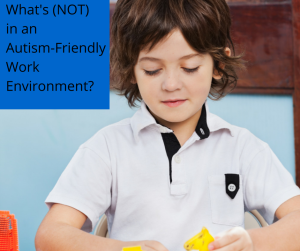
When we set up home-based ABA Therapy for our clients all over New Jersey, there are a few guidelines that we follow. These are drawn from best practice and provide helpful guidelines for setting up your therapy area.
- Furniture such as table and chairs should be an appropriate size to the learner. Young learners should be able to place their feet on the floor. Older learners should have plenty of room between their knees and the table. Physical comfort goes a long way towards learning! Imagine working all day at a desk where your feet didn’t touch the ground. Suffice to say you’d be distracted from the task at hand.
- Organize the room so that the child can access materials independently. It’s important to teach children how to get their own materials, toys, games, and reinforcers. Organization can be storage drawers, toy shelves, or any other system that keeps clutter hidden while being accessible to the learner. Shelves and drawers should be at a height the child can easily reach ~ not requiring a stepstool, nor having to stoop down.
- Start with a designated, distraction-free space. Free of distractions means: No posters or wall decals and no siblings running through the space. Minimize noise from dogs barking, other children playing, and so forth. A distraction free work environment may also need to be free of toys or desired items that might trigger maladaptive behavior until the child learns to tolerate preferred items in his or her work environment. Over time, build in distractions systematically so that the learner can adapt to more typical set ups.
- Use visual or text supports to label materials. Using pictures, cartoons, words, or symbols, label the materials and drawers in the work area. Your BCBA or child’s teacher can recommend what kinds of labels to use. Early learners often can learn to match photographs easily. Students who are able to read might prefer a more sophistacted, text-based environment. Visual supports will help your learner be more independent within his or her own environment.
- The work environment should support plenty of room for the child and therapist or team to move around. Avoid cluttering the room with extra, unnecessary furniture, toys, activities, and other “stuff” that might need to be managed. The area should have room to work at the table or desk, as well as adequate, uncluttered floor space for playing, break time, and natural environment teaching.
- During the work session, the work surface should be free of any items that are not in use by the learner. The learning materials required for a trial, and a motivational system/token board should be the only items on the table. Therapist clipboards and data sheets. DRO timers, extra materials, pens, pencils, and other distractions should be located elsewhere.
The most important aspect of an Autism-Friendly work environment is that it is individualized to the learner’s needs. Over time, the environment should evolve to mimic more typical learning environments, such as school. These guidelines are a starting point for your early learner’s home program setup.
In this series, we’re hoping to help eliminate some of the overwhelm associated with setting up a home ABA therapy program. Other posts in this series:
What Materials Do I Need to Start My ABA Home Therapy Program?
What’s a Reward vs. a Reinforcer?
Who’s on My ABA Therapy Team: Part 1 (ABA Therapist)

Leave a Reply